Can you clearly remember the last ad you saw and what it said, whether it was on social media or TV? If not, that’s totally understandable! The average person sees thousands of ads per day, making advertising overload a common occurrence. But some types of advertising are much better than others at raising brand awareness and creating long-lasting brand recall.
According to Nielsen, branded content in particular is much more than effective than pre-roll advertisements on these metrics, with 86% brand recall among survey respondents compared to only 65% for pre-roll ads. This effectiveness comes with a tradeoff, though (doesn’t everything?): Branded content is expensive to produce and distribute.
However, there’s an economical but still highly reliable alternative, in the form of sponsored content and its deployment through sponsored content marketing.
What is sponsored content marketing?
Sponsored content is a long-form or otherwise in-depth asset — from a blog post to a video — whose production is funded by a sponsor, but whose creation and distribution is handled by a partner, which in turn ensures that the asset closely resembles the non-ad content on its platform. This partner can be a website, an influencer social media account, a popular podcast or any other forum in which the sponsor’s target audience is likely to see the content in question.
So how do sponsored posts work?
Any piece of sponsored content will have three components:
- A sponsor: A brand that pays the external partner to produce and distribute the content.
- A partner: Either a media platform (like a website) or an individual influencer’s account, where the target audience is and where the sponsored content will live.
- An asset: The actual sponsored post, video, image or podcast.
Here’s a relatively simple, classic example of sponsored content, from the political news website Politico (annotation added):
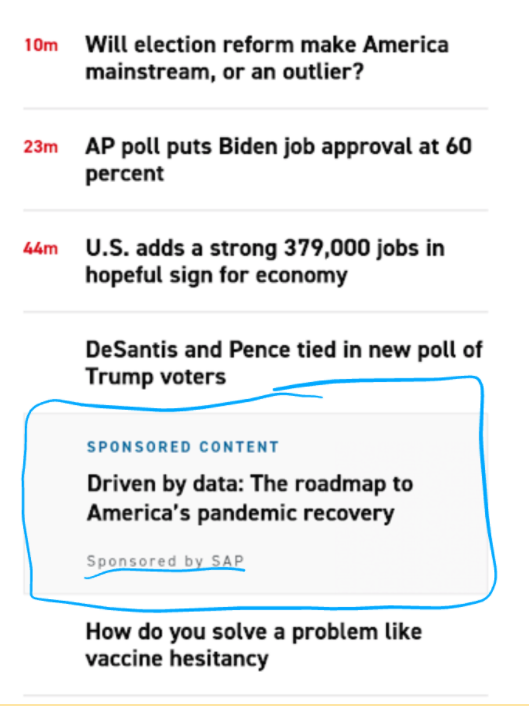
The sponsor is SAP, the partner is Politico and the sponsored content itself is a blog post. When clicked, the sponsored article looks basically like any other piece of content on the Politico site, with an accordion menu, pull-quote, Facebook and Twitter buttons and the “Politco” banner.
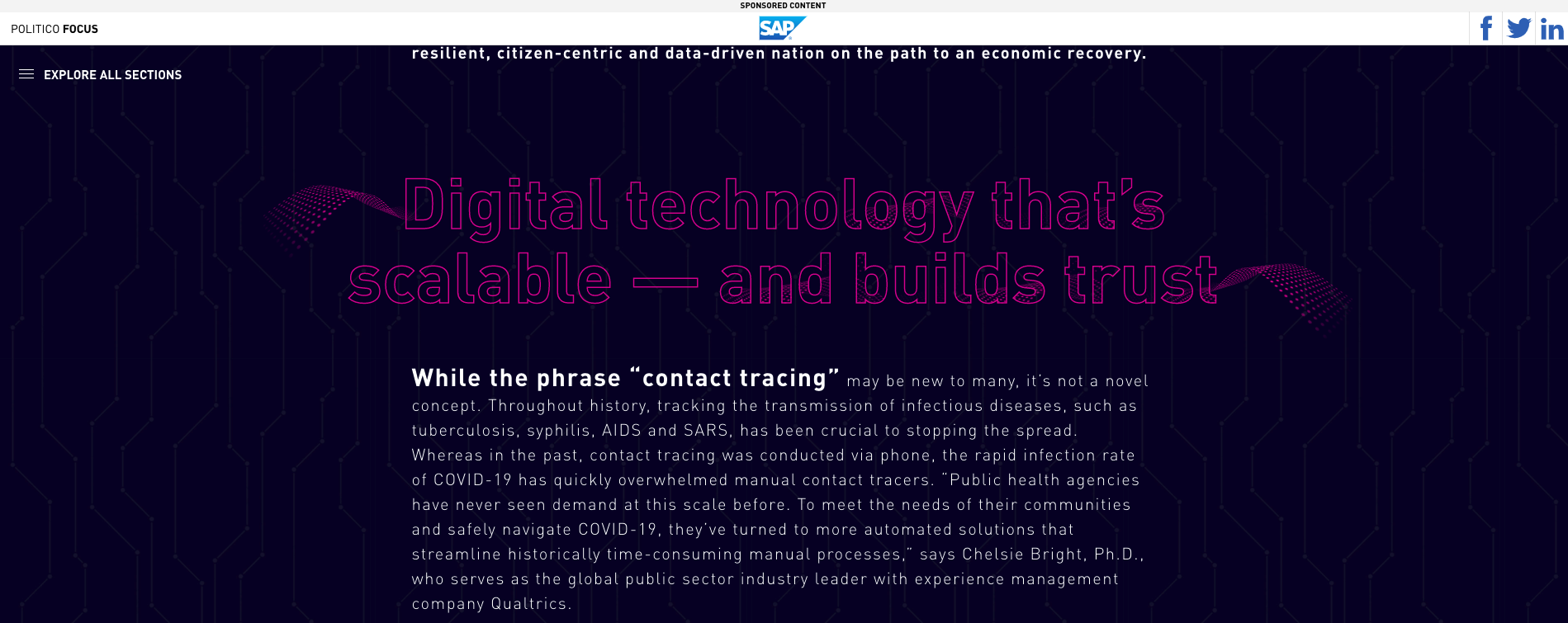
Sponsored posts like this one are useful to marketers because they build audience trust and also burnish the brand’s image as an authoritative source (“thought leader,” even) in ways that an intrusive ad might not. The long-form/in-depth nature of sponsored content is key.
Sponsored content and influencer marketing
A sponsored content campaign may also run through a specific influencer’s account.
Influencer marketing and sponsored content work well together because influencers have the demonstrated ability to sway the decisions of a large and specific audience that the sponsor is trying to reach. Influencer marketing partnerships provide precision, by selecting for particular audiences that match a sponsor’s focus area and marketing goals, thereby increasing the likelihood that the campaign will feel relevant to the people who encounter it.
Moreover, many social media platforms, Instagram in particular, are aspirational, with users following and engaging with accounts that present products, services and lifestyles they wish they had. It’s in this context that sponsored posts from influencers, who will in most cases be promoting something that their audience is highly predisposed to like, can really resonate with the influencer’s audience.
This post from a lifestyle influencer shows a very positive response in the comments to the influencer’s promotion of a liquid vitamin:
View this post on Instagram
The influencer’s long-term focus on wellness and mindfulness meant that her account was already fertile ground for a sponsored content campaign for vitamins. Basically, the sponsored post is a natural fit here, and one that doesn’t look like an ad except for the “Paid partnership with…” disclaimer above and the #ad hashtag below.
Speaking of paid, influencers make money from brands (sponsors), which pay them to produce and promote a message to their readymade audiences. The sponsor then aims for ROI on that spend through the increased brand awareness and subsequent conversions, among an audience predisposed to be receptive to its message.
But why bother with this type of carefully crafted and targeted content in your content marketing campaigns, when native advertising already exists? We’re glad you asked, because these two approaches are not the same despite some similarities.
What’s the difference between sponsored content and native advertising?
Simply put: Sponsored content is a subset of native advertising.
Native advertising includes the full range of advertising types designed to resemble the non-ad content on their respective platforms. In-feed social media ads and even search display ads fit into this bucket, alongside the longer-form, higher-production value content examined above. Consider this result for “coffee” in DuckDuckGo:
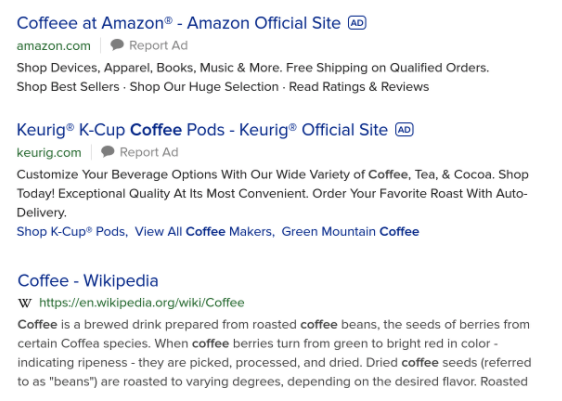
The top two results are clearly marked as “ads,” but they still semantically resemble the first non-ad result from Wikipedia. This example underscores the vast range of native advertising, which unlike the narrower category of sponsored content doesn’t have to be long-form. It can be as simple as a search ad or a sponsored pin on Pinterest.
When producing branded content, it can pay to diversify your approach by using both short- and long-form types of native advertising. Doing so opens up more possibilities. For instance, this Instagram native ad from Pathstream leads to an application form, not a blog post like a piece of sponsored content might:
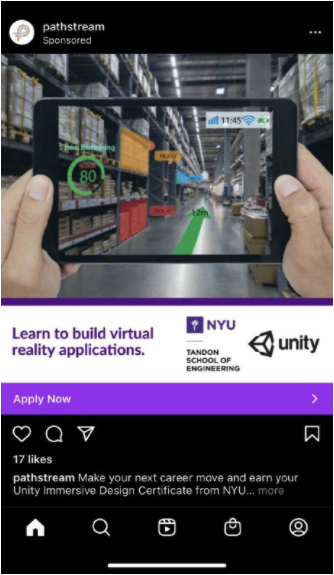
Note that some platforms, most notably LinkedIn and Facebook, treat native advertising and sponsored content as nearly synonymous.
In LinkedIn’s case, what it calls sponsored content is a little different than the main types of sponsored content elsewhere, as LinkedIn Sponsored Content mainly consists of page updates, image and video ads and job postings — i.e., native advertising. Here’s a look at an in-stream sponsored post with a video:
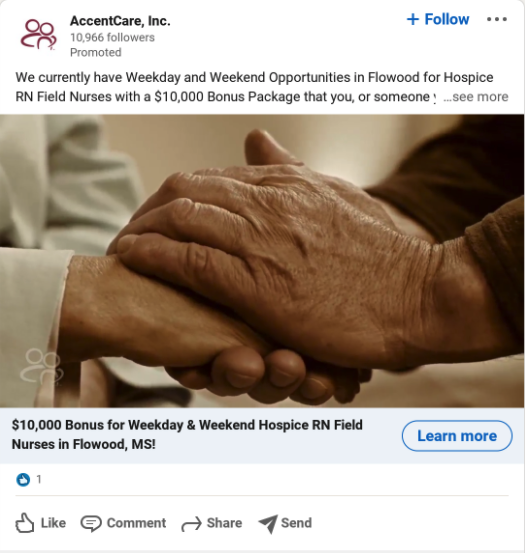
It looks like a regular LinkedIn post, but it links to a job board and is denoted as “promoted.” Unlike the Instagram post above, the content is not self-contained within the sponsored post itself, but instead directs you to an external site like an ad (including a native ad) normally would.
Similarly, this Red Hat post on Facebook is somewhere between native advertising and sponsored content. It leads to a long-form and in-depth asset like a sponsored article on a website would (an eBook in this case) but as above, you have to leave the platform itself — you don’t read the eBook within Facebook proper.
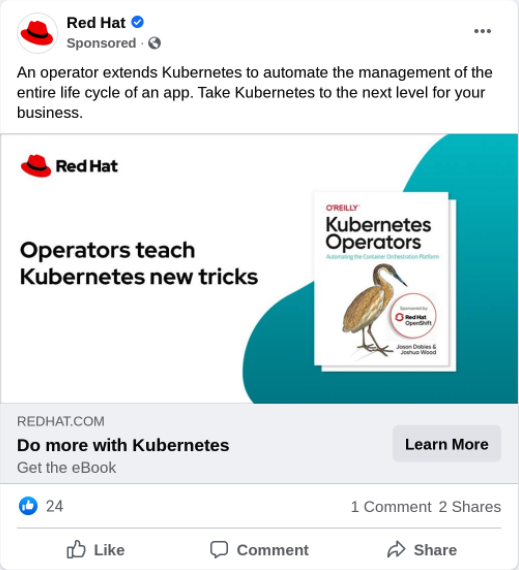
To sum it all up, on LinkedIn and Facebook, unless the sponsor is working through an influencer’s account or using something like Facebook boosted posts, the results veer a little closer to native advertising as we’ve defined it, despite the “sponsored content” nomenclature.
What are the benefits of using sponsored content?
Sponsored content (and native advertising more broadly) is useful to marketers for several reasons.
1. Sponsored content usually performs better than display ads
A famous saying about advertising is that half of it works, but it’s unclear which half. But with the rise of more advanced marketing analytics, it’s now easier for marketers to separate the ad wheat from the chaff, and to see that their sponsored content works a lot better than a traditional display advertising.
How much better? Try almost nine times the click-through rate, per an AppNexus paper on the subject.
The “natural” look and feel of sponsored content and native advertising, whether in a social media feed or a website’s homepage, makes viewers feel more comfortable clicking. Once they do, they may be more likely to do so in the future, too, since they know they’ll see something resembling a “normal” article, video or podcast, instead of ad redirect.
2. Sponsored content is likelier to be seen
Ad blockers have become more common over time. And they’re not the only obstacle that ad networks must overcome to reach a target audience. Too-low bids as well as the overall complexity of ad delivery (check out our full guide for more details) means that a campaign might yield unpredictable results.
By comparison, sponsored content is easier to set up and show to viewers. It’s easy to publish directly to a site or social media platform, and also won’t be caught by an ad blocker or get buried in a pop-up that the user will ignore or close. Viewers may even see it and click through without first recognizing that the content is sponsored.
3. Sponsored content drives conversions
A Collective Bias survey once found that one-third of millennials had purchased something after seeing sponsored content from its brand. The superior brand awareness and recall associated with sponsored content helps drive this high level of sales activity.
More specifically, branded content is often perceived as offering authentic and useful information that the target audience is already looking for when it’s searching through blog posts and other organic content. That’s distinct from display ads, which, although they can work under some circumstances, can often seem irrelevant and disruptive. The use of influencer marketing partnerships in sponsored campaigns is one reliable way in which marketers ensure the right fit between the content they’re producing and the audience they’re targeting.
4. Sponsored content seems “premium”
The production value and design of the best sponsored content can make it so compelling that its target audience proactively seeks it out and/or continues to willingly engage with it over the long-term — two behaviors that don’t really apply to the consumption of other types of advertising.
Indeed, Netflix has been a pioneer in sponsored content and native advertising that blurs the line with the highest-quality original content. “The Goop Lab,” its series about Gwyneth Paltrow’s wellness company, is nominally a documentary. But underneath its prestigious TV veneer are ten episodes of branded content for Goop’s products, designed to continually but subtly reinforce brand awareness.
What are the different types of sponsored content?
Sponsored content is usually associated with the types of “sponsored post” or “ad” flagged articles on websites, but it comes in many other forms, too. Sometimes, identifying it is as simple as seeing a disclaimer (“presented by,” for instance, or “this episode is sponsored by…” on a podcast), and in other instances the branding might be more subtle, as in the case of The Goop Lab.
You are likeliest to find sponsored content in the following forums:
- Social media feeds, especially Instagram, LinkedIn, and Facebook, which offers their own proprietary advertising formats for it.
- Media websites and blogs that routinely publish longer-form written content and can accordingly make a sponsored post a natural fit.
- Podcasts, which are frequently sponsored by companies like ZipRecruiter and may promote the sponsor’s specific cause.
- Video platforms such as YouTube and Netflix, where the sponsoring brand can either pay an influencer (as on YouTube) or collaborate with the platform itself (as with Netflix).
Native advertising and sponsored content are both heavily customized by definition, but they fit into a few general categories:
1. Sponsored posts on influencer social media accounts
We mentioned Instagram native advertising earlier and how it is designed to seamlessly fit into the social media platform’s feed. Sponsored influencer content on the same platform looks a little different.
Somewhat confusing, it’s denoted at the top of the post by “Paid partnership with [sponsoring brand]” instead of “sponsored,” as in this example from an influencer marketing account:
View this post on Instagram
This sponsored post fits well with the influencer account’s other updates, which are all about DIY home improvements that followers can easily perform. Crucially, it doesn’t hit the viewer over the head, but still manages to raise brand awareness of the sponsor, which gets @-mentioned in the caption. The #sponsored hashtag is also used. The latter practice is important for complying with Federal Trade Commision rules about social media.
Overall, this type of sponsored content campaign works because:
- It aligns with the particular interests (home improvement product selection and tips) of the influencer’s audience. The partner account here has over 150,000 followers on Instagram alone, making the sponsored post a worthwhile play for the sponsor and its brand awareness goals.
- It’s seamlessly integrated into the feed, looking almost identical to organic content and being completely consumable without leaving the platform. Viewers can see the branded content, decide if they want to engage with the sponsor itself and go about scrolling their feed without disruption. They don’t have to leave the platform.
- It provides an easy way for the target audience to engage with the brand if they want to, via the @-mention. There isn’t the overt call to action or CTA button that might be found in a native ad.
2. Sponsored articles
A sponsored article is usually a long-form blog post designed to look and feel like the other content on the site or app. Since we already covered a “classic” example of a sponsored article with the Politico example — which is differentiated in the site’s list of stories and appears similar but still noticeably different from a regular post — let’s look at something that’s even more interwoven into the partner site’s design.
This BuzzFeed article from Hidden Valley Ranch could easily pass for a piece of non-sponsored content (annotations added):
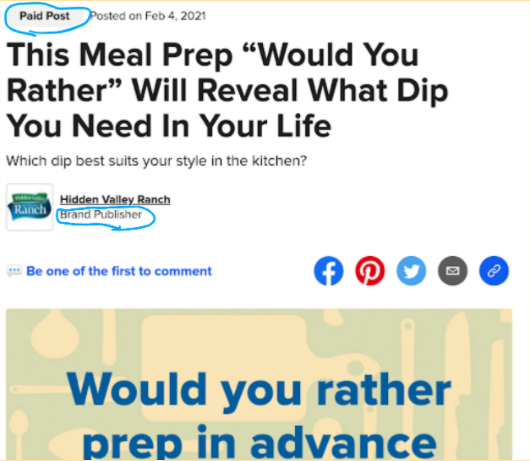
The two giveaways that it’s sponsored content are circled, but otherwise it’s built to resemble what the audience already expects when reading normal content on BuzzFeed. The article is an interactive piece about selecting dip, and as such it raises brand awareness of Hidden Valley Ranch’s products.
3. Sponsored videos and images
Social media is a mostly visual medium (we didn’t forget about Clubhouse), and so it’s no surprise that marketers incorporate videos and photos into sponsored campaigns. The previous influencer examples from Instagram show how sponsored videos and images can connect with a particular target audience.
Let’s branch out and look at another hotbed of sponsored content and influencer marketing: YouTube. This YouTube video from influencer Chriselle Lim (over 700,000 subscribers!) is a high-quality sponsored post supported by Aldo:
She goes for a walk and provides detailed critiques of the different shoes she wears. The pitch for Aldo, the sponsor, doesn’t come up until near the end, by which point it feels pretty natural — the viewer has already been hooked by her compelling analysis of how shoes fit with specific outfits, not to mention the video game animations and sound effects that accent her remarks.
4. Sponsored podcasts
Somewhere in the mid-2010s, podcasts went from a niche obsession of technology bloggers, electronic music producers and public radio enthusiasts, to a widespread cultural phenomenon. Understandably, they’ve also become prime forums for sponsored content campaigns.
BMW even sponsored an entire podcast series called “The Special.”
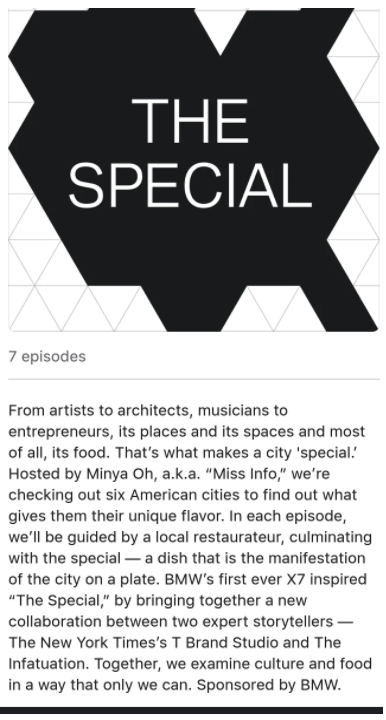
This podcast blends storytelling about specialty foods from different U.S. cities with promotion of BMW’s X7 Sport Activity Vehicle — you know, for traveling between all these locales with their yummy food. It’s a good example of the podcast partnership taken to a new level as the sponsor drives (pun intended) the actual discussion instead of just being the subject of a standard advertising read.
3 sponsored content best practices
So, how can you get the most mileage out of a sponsored campaign? Let’s examine three best practices for successful sponsored marketing.
1. Sponsor influencers (or sites) with a similar audience to your own
This is the big one. For sponsorship to pay off, you have to select partners with audiences likely to be receptive to your message and brand values.
For example, a skin products company would likely see much better results from sponsoring a YouTube influencer who did skincare product reviews and tutorials on their social media accounts, than from sponsoring one who did video game playthroughs.
That’s what Neutrogena did in this sponsored post, a makeup tutorial, from a YouTube influencer in the skincare space. The video is clearly marked as an ad, but the content itself is informative and engaging, as if it were something she would normally post to her feed.
2. Prioritize engaging content over the sales pitch
One of the main value propositions of sponsored content is that it doesn’t feel like advertising. Accordingly, try not ruin it with a heavy-handed sales pitch that will distract the audience from what you’re showing them.
That doesn’t mean you can’t pitch the product at all — far from it. But ensure that you have the content’s quality and presentation nailed down before you begin explicitly telling people to buy something. With engaging and properly branded content, you can nudge audiences pretty far along in their buying journey.
Netflix’s sponsored content created with The Wall Street Journal shows how you can balance quality and salesmanship. The (very long) article is meant to promote the show “Narcos,” and has the branding to prove it, but it’s an exciting read on its own.

3. Branch out beyond sponsored articles
Articles are the assets most closely associated with sponsored content, but they’re far from your only options. It’s useful to pursue a multichannel content marketing strategy across websites, social media platforms and podcasts, if only to see which channels and formats provide the best results.
When Will Ferrell revived his Ron Burgundy character for a 2-season podcast series, he delivered all of the sponsored ad reads in character, making the sponsors’ messages an integrated part of the show. Here’s how he talked about Sponsor Safe Auto:

Sponsored content provides a variety of opportunities for reaching audiences in creative ways that they might not expect from advertising. The best sponsored content feels like high-quality media in its own right and helps sustain audience interest. We hope you’ve found this guide helpful as you embark on your own sponsored campaigns!





